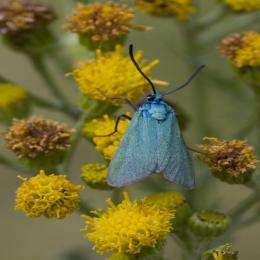Fossil moths reveal their true colors

Moths dead for 47 million years are again showing their true colors. For the first time, scientists have reconstructed the colors of an ancient fossil moth. The findings detailed not just a few spots of color, but the appearance of the entire organism.
Maria McNamara, a researcher at Yale University in New Haven, Conn., presented the findings October 9 at the annual meeting of the Geological Society of America in Minneapolis, Minn.
In recent years, scientists have begun painting a colorful picture of prehistoric life on Earth by reconstructing colors from fossilized animals including dinosaurs and early birds.
Those dinosaur colors were preserved as pigments within the fossils. The palette of the fossil moths was produced not by pigments, however, but by physical structure.
Moth wings contain patterns of microscopic structures including ridges, cross-ribs, and branching micro-ribs. When light bounces off of these structures, it scatters in a specific way, producing visible color.
Structural color exists in insects, birds, mammals, fish, and even plants. In September, McNamara and her colleagues reported that they'd deciphered the structural colors of ancient beetle fossils. Moths presented a more sophisticated challenge. "[Structural colors] are most diverse, and most complex, in butterflies and moths," McNamara said in her presentation.
With that complexity in mind, she and her colleagues studied a collection of fossil moths unearthed from the oil shales of Messel, Germany, a site famous among paleontologists for its exceptionally preserved fossils. The moths were similar to modern-day forester moths, a group of bright metallic moths in the family Zygaenidae.
Studying the microscopic structures in the fossil moths' wings, the researchers reconstructed how the insects appeared in life. The moths' bodies were bright yellow-green, and they also sported yellow-green wings rimmed in blue. Unlike their modern cousins, however, these fossil moths did not appear metallic.
Moth and butterfly scales are made up of layered sheets that typically produce iridescent colors. These colors appear to change hue, and seem to flash on and off, depending on the viewing angle.
But the fossil moths suppressed their shimmer and flash. Various physical structures such as tiny holes and well-spaced ridges on the moth’s scales dampened the iridescence, resulting in bright, solid color that was visible from nearly any angle.
McNamara's research is just the latest in a series of recent studies that have looked at fossil colors, said Andrew Parker, a research leader at Oxford University's Green Templeton College and the Natural History Museum in London, and an expert in the evolution of structural color in nature. But the new findings are notable, he added, because they revealed colors over the moth’s entire wing surface.
"Finding a scrap of pigment in a dinosaur doesn’t tell you anything," he said. "Finding the complete color of a moth tells you about the type of predator-prey relationships that were happening at that moment in time. You can start to reconstruct a whole ecology."
Insects, like many animals, use colors to communicate all sorts of messages – both with members of their own species and others. Color patterns can provide camouflage, send signals to potential mates, and even warn predators that the colorful creature is not to be messed with.
The bright color of the fossil moths suggests that the insects were active during the day, McNamara said during her presentation. The vivid yellow-green hue probably served a defensive function. When resting on leaves, the moths would have blended into their surroundings, hidden from predators. When feeding on colored flowers, on the other hand, their bright tint may have sent a warning signal.
Living forester moths are highly toxic, and their bright coloration warns predators to keep their distance. The vivid colors of their fossil forebears suggest they, too, may have been deadly to would-be predators.
Seeing long-dead moths in living color is "an exciting advance," said S. Bruce Archibald, an expert in fossil insects at Simon Fraser University in Burnaby, British Columbia. "The new, detailed knowledge provided by this study helps us understand more clearly how ancient [animal] communities functioned."
Source: Inside Science News Service




















